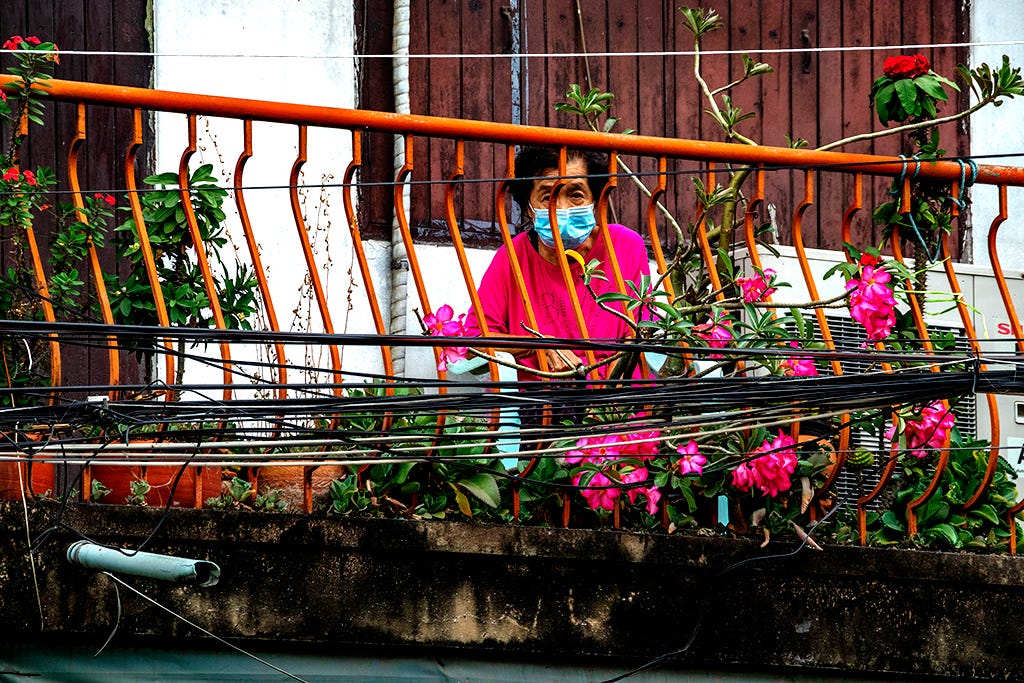[Bangkok, 10/13/22]
Yesterday, I went to the US Embassy to apply for a new passport. As expected, it’s in an affluent and sophisticated neighborhood, with the ambassador’s residence set apart from the embassy itself.
It’s a country estate on the most expensive street in an overcrowded city, befitting a representative of the baddest and coolest empire ever. As I photographed its gate, a chubby white woman with green hair and a cutesy tattoo on her arm walked into the frame. For some reason, Bangkok has more tattooed white people than just about any place on earth.
Since the 9/11 false flags, many American embassies and consulates have turned into fortresses, with armed soldiers, concrete barriers and even adjacent roads blocked off, but the Bangkok one is quite low key, with all its employees, Thai or American, very pleasant. Though dealing with bureaucracy is never fun, I managed to handle yesterday’s procedure with only minor confusions. Since cameras weren’t allowed inside, I had to leave my bag with some guy 200 yards down the street. Charging $6 per bag, dude has a nice, sweat-free business going.
In the same neighborhood are also embassies of Japan, Australia, Netherlands, Sweden, Switzerland, New Zealand, Poland, Czech Republic, South Africa, United Arab Emirates and Vietnam, the last directly across from the American ambassador’s residence. I wonder if Robert Godec has an occasional nightmare of Vietcong sappers scaling his not-high-enough walls?
Dwelling in houses, apartments, motels, lodges, shelters, shacks, vans and cars, we get by. They reside.
Before Thailand, Godec was the ambassador to Kenya for six years, then Tunisia for three. Though you might find it strange that an American diplomat has been shuffled through three countries with nothing in common, it’s standard practice. To prevent them from getting too chummy with locals, thus prone to favors asked or granted, these diplomats are routinely parachuted into places they have little knowledge of. You think Godec’s Thai is better than mine? Having spent a month in Thailand over four visits, I can barely remember sa wa dee!
Moving through countries constantly won’t likely make your wife happy, and it’s also child abuse, so a high percentage of American diplomats are gay. Few nations please this persuasion more than Thailand. Since Godec is straight, he’s depriving some deserving homosexual of such a plum job, with lots of whipped cream and a cherry on top.
Wandering around Lumphini, I got glimpses of how the upper fifth or sixth live. At Central Embassy, there were Gucci, Chanel, Jimmy Choo, Givenchy, Michael Kors, Kenzo, Moschino, Prada, Balenciaga, Bottega Veneta, Ralph Lauren, Fred Perry and Hermès Paris stores, etc., on and on.
Kenzo had a large photo of four models, three Orientals and one ink-black, wearing a line of clothing, 1970, by a Japanese designer, Nigo. With its varsity jackets, leather jackets, zip cardigan sweaters, nerdy yet sexy skirts and clunky shoes, it’s inspired by American highschoolers, as projected by Hollywood films, Grease above all. Instead of the sassiness of a young Olivia Newton John or John Travolta, the Kenzo models are lifeless, however, with vapid expressions and limp postures. Dolled up dorks are in. Cryogenically cool, it’s as if they’ve been brought back to life after half a century. That America is beyond dead.
[Kenzo in Bangkok, 1/11/23]
Central Embassy’s toilets had heated seats and jets of warm water for your rear and front, so your hand could avoid your anus, for once. On a pedestrian bridge just outside the shopping mall, there was an old, leprous female beggar with only stumps for fingers.
I passed Maison Saigon. Though its menu seemed very authentic, with prices reasonable enough, I balked. No colonial chic for me.
In Cairo, most embassies are on an island in the Nile, so it’s a colony of the super cosmopolitan, with their divorce from ordinary Egyptians. While donkey carts may roam downtown Cairo, SUVs steer through Zamalek. The names of its restaurants might as well be found among Bangkok’s cluster of embassies. There’s Aperitivo, Porto Vecchio, El Caprice Lounge, Butcher’s Burger and Maison Thomas Pizza, etc.
Diplomats, then, exist inside penthouses, and that’s also true of politicians, of course. They aren’t just removed from our nickel-and-dime worries and afflictions, but willfully blind to them. As we squat outside the theater, they perform for their peers on a brightly lit stage.
Since it took some effort to reach Lumphini, I should have spent more time there, but I quickly tired of it, so hurried back to my lovely fleabag in grubby Phranakorn. On the way, I stopped at Wat Pho, famous for its huge reclining Buddha.
[Wat Pho in Bangkok, 1/11/23]
There’s a gallery of world leaders who have visited this temple. Beaming winning smiles as they chat with a monk, Obama and Hillary Clinton are pictured together. Seasoned performers, they look perfectly benign and charming, these sinister careerists. Satanists also go to church, of course. Though the monk may be just as corrupt, he doesn’t have the power to do as much damage.
So where are we, two weeks into 2023?
Europe has experienced record warmth, so no one has frozen to death, and the ground in Ukraine is only now hard enough for that much anticipated Russian offensive. Preparing for this, Putin has appointed a new commander. Mocking this “reshuffle,” CNN suggests it’s actually a “demotion” for General Gerasimov, for he’s been handed a “poisoned chalice.”
In France, the Yellow Jackets are mounting protests against inflation and lower standards of living, but street rallies won’t do anything. Only with forceful disruption to business as usual can we even begin to hope for change. The Canadian Truck Convoy attempted this but failed. Occupy Wall Street degenerated into an incoherent, thus self-canceling, mess of tent cities, with Wall Street itself never stalled, much less occupied.
With statistics and studies clearly showing how harmful the Jewjabs have been, they’re still being pushed, and in otherwise normal Bangkok, mask wearing is nearly universal, even on infants. Inside a subway car, I stood next to father holding his two-year-old son. The masked kid wouldn’t stop crying. All his life, he’d been suffocated in public and, who knows, maybe even at home.
On a second floor balcony in Wang Burapha Phirom, an old woman sat alone, yet masked. Along with billions on this sick earth, she had lost her mind.
[Bangkok, 1/11/23]
With flash points in Palestine, Syria, Iran, Korea, Taiwan, Kosovo, Brazil, Mexico, Pakistan and, frankly, all of Europe, we’re sinking deeper into crisis, if not catastrophe.
A month ago, South Sudan’s dictator was filmed pissing in his pants during the national anthem. Always natty with his well-tailored suits, red ties, shades and Stetson hats, etc., Salva Kiir is now exposed as an emperor without diaper.
His collapse into an animal state mirrors that of soldiers under fire, for no adults wet and soil their pants as much as men in military uniforms, for war does that. It turns humans into beasts, often terrified.
Masked, locked down, poisoned, brainwashed, bankrupted, laid off, starved or even bombed, we’re already shadows of ourselves. Only yesterday, we had our wits about us and stood tall.
[Bangkok, 1/11/23]








Hi everyone,
I just got the below message at my blog, as sent by Blogger/Google. Should my blog of +13 years be terminated from additional flags or "violations," SubStack will be my only home. So be it, for I'm not going to censor myself.--Linh
Hello,
As you may know, our Community Guidelines
(https://blogger.com/go/contentpolicy) describe the boundaries for what we allow-- and don't allow-- on Blogger. Your post titled "My comment at SubStack, after my latest:" was flagged to us for review. We have determined that it violates our guidelines and deleted the post, previously at
http://linhdinhphotos.blogspot.com/2023/01/my-comment-at-substack-after-my-latest.html.
Why was your blog post deleted?
Your content has violated our Hate Speech policy. Please visit our Community Guidelines page linked in this email to learn more.
If you wish to request a review of the post, click the following link:
https://www.blogger.com/go/appeal-post?blogId=4284893230469697578&postId=8793990428039740616.
This will trigger a review of the post.
We encourage you to review the full content of your blog posts to make sure they are in line with our standards as additional violations could result in termination of your blog.
For more information, please review the following resources:
Terms of Service: https://www.blogger.com/go/terms
Blogger Community Guidelines: https://blogger.com/go/contentpolicy
Sincerely,
The Blogger Team
I'm always intrigued by where you write about and often look at google earth to see the surroundings. In this case it's true that the US Ambassador's residence appeared to be an anomoly in the middle of a chaotic city but it used to be a large colonial house on a lake. https://th.usembassy.gov/cmr-history/
"By the late 1800s, the area east of Rattanakosin was filled with verdant rice fields, interlaced with large and small khlongs and dotted by small, scattered farms.
...
Personifying Bangkok’s boom growth was English engineer Horatio Victor Bailey. By 1913, Bailey was a well-connected Bangkokian, having worked for Bangkok Dock Company and later as Engineer-In-Chief to the Royal Mint Department. Bailey then founded his own engineering consultancy and an import company.
...
Bailey sited his house at the back third of the property, in view of but at a discrete distance from the dirt road that inevitably would be developed someday. Walking on a path from the front drive south of the house, Bailey’s prominent bathing sala would come into view, and adjacent to it, Bailey widened and deepened the western and southern border canals to form a large, square bathing pond.
...
For the main house architecture, Bailey chose a playful combination of European colonial, restrained gingerbread and tropical Malaysian designs, harmonized with Siamese architecture’s elegance, intricacy and neatness. His design was consistent with several other houses built in Bangkok at the time."
Annoying as it might seem to us that one man lived in such luxury (before he turned 40!), all credit to the Americans for retaining the historical building for as long as they did, having bought it in 1927. However looking at the latest aerial photos it's evident that they've now demolished the house, filled in the lake, destroyed the surrounding parkland and are in the process of erecting an abysmal edifice in its place.
To me, nothing is as edifying about a culture as watching how it treats the historial buildings it 'owns' and, if it demolishes them, what it erects as their replacement. The American, British and French attitude towards the architectural heritage they have been bequeathed is often lamentably philistine.